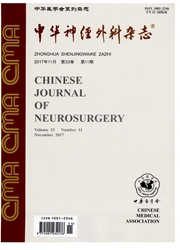

 中文摘要:
中文摘要:
目的探讨家系遗传性2型神经纤维瘤病(NF2)基因突变的规律和临床特点。方法回顾性研究首都医科大学附属北京天坛医院2011年1月至2014年12月诊治的15个家系37例NF2患者。获取患者31份血液标本和15份(每个家系各1例)肿瘤标本,同时获取健康对照者血液样本74份(家系中健康人24份,无血缘关系健康人50份)。采用Sanger测序法对NF2基因编码区及邻近内含子进行测序;采用Kaplan—Meier生存曲线分析,比较不同突变类型及不同突变患者的生存期。结果在NF2患者血液及肿瘤标本中分别测到15种和18种NF2基因突变类型,包括2种无义突变,4种错义突变,6种移码突变,1种框内缺失突变,5种剪切位点突变,其中14种为未见报道的突变类型;所有健康者均未发现NF2基因突变。Kaplan—Meier生存曲线显示,18例NF2基因无义突变/移码突变组患者的中位生存时间为(120.0±20.3)个月,11例错义突变组中位生存时间为(288.0±91.7)个月;14例突变位点位于NF2基因1~7外显子组患者的中位生存时间为(120.0±15.3)个月,15例突变位点位于8—11外显子组患者的中位生存时间为(276.0±19.6)个月,差异均有统计学意义(P=0.01,P=0.005)。结论NF2基因突变检测是早期诊断和疾病筛查的重要方法,突变方式和位点是判断NF2病情发展和预后的重要依据。
 英文摘要:
英文摘要:
Objective To investigate gene mutation and clinical features in families with hereditary neurofibromatosis type 2 (NF2). Methods From January 2011 to December 2014, 37 patients with NF2 from 15 pedigrees treated in Beijing Tiantan Hospital, Capital Medical University were enrolled retrospectively. Thirty-one blood samples and 15 tumor samples (1 case from each pedigree) from patients were obtained; meanwhile, 74 blood samples from healthy controls (24 samples from healthy persons in the pedigrees and 50 samples from healthy persons without kinship) were obtained. Sanger sequencing method was used to sequence the NF2 gene coding region and its adjacent introns. Kaplan-Meier survival curve analysis was used to compare the different types of mutations and the survival period of the patients with different mutations. Results Fifteen and 18 NF2 gene mutation types were detected from blood and tumor samples in patients with NF2, including 2 nonsense mutations, 4 missense mutations, 6 frameshift mutations, 1 in-frame deletion mutation, and 5 splice site mutations, 14 of the mutation types had not been reported. No NF2 gene mutations were detected in all the healthy subjects. Kaplan-Meier survival curves showed that the median survival time of the 18 patients in the NF2 gene nonsense/frameshift mutation group was 120.0±20.3 months ; that of 11 patients in the missense mutation group was 288.0 ± 91.7 months ; and that of mutation site located in the NF2 gene 1-7 exon group of the 14 patients was 120. 0 ± 15.3 months; and that of mutation site located in the NF2 gene 8-11 exon group of the 15 patients was 276. 0 ± 19:6 months. There were significant differences ( P = 0.01, P = 0. 005 ). Conclusions NF2 gene mutation detection is an important method of early diagnosis and screening. The mutation style and sites are the important bases for identifying NF2 disease progression and prognosis.
 同期刊论文项目
同期刊论文项目
 同项目期刊论文
同项目期刊论文
 期刊信息
期刊信息
